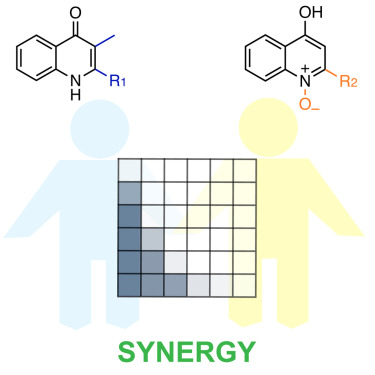当前位置:
X-MOL 学术
›
Cell Chem. Bio.
›
论文详情
Our official English website, www.x-mol.net, welcomes your
feedback! (Note: you will need to create a separate account there.)
Synergy and Target Promiscuity Drive Structural Divergence in Bacterial Alkylquinolone Biosynthesis
Cell Chemical Biology ( IF 6.6 ) Pub Date : 2017-10-12 , DOI: 10.1016/j.chembiol.2017.08.024 Yihan Wu , Mohammad R. Seyedsayamdost
Cell Chemical Biology ( IF 6.6 ) Pub Date : 2017-10-12 , DOI: 10.1016/j.chembiol.2017.08.024 Yihan Wu , Mohammad R. Seyedsayamdost

|
Microbial natural products are genetically encoded by dedicated biosynthetic gene clusters (BGCs). A given BGC usually produces a family of related compounds that share a core but contain variable substituents. Though common, the reasons underlying this divergent biosynthesis are in general unknown. Herein, we have addressed this issue using the hydroxyalkylquinoline (HAQ) family of natural products synthesized byBurkholderia thailandensis. Investigations into the detailed functions of two analogs show that they act synergistically in inhibiting bacterial growth. One analog is a nanomolar inhibitor of pyrimidine biosynthesis and at the same time disrupts the proton motive force. A second analog inhibits the cytochromebc1complex as well as pyrimidine biogenesis. These results provide a functional rationale for the divergent nature of HAQs. They imply that synergy and target promiscuity are driving forces for the evolution of tailoring enzymes that diversify the products of the HAQ biosynthetic pathway.
中文翻译:

协同作用和目标混杂驱动细菌烷基喹诺酮生物合成中的结构差异。
微生物天然产物由专用的生物合成基因簇(BGC)进行遗传编码。给定的BGC通常会产生一族相关的化合物,它们共享一个核心,但含有可变的取代基。尽管很普遍,但这种生物合成差异的原因通常是未知的。在这里,我们已经使用由泰国伯克霍尔德氏菌合成的天然产物羟烷基喹啉(HAQ)系列解决了这个问题。对两种类似物的详细功能的研究表明,它们在抑制细菌生长方面具有协同作用。一种类似物是嘧啶生物合成的纳摩尔抑制剂,同时破坏质子原动力。第二种类似物抑制细胞色素bc1复合体以及嘧啶的生物发生。这些结果为HAQ的不同性质提供了功能上的依据。
更新日期:2017-12-21
中文翻译:

协同作用和目标混杂驱动细菌烷基喹诺酮生物合成中的结构差异。
微生物天然产物由专用的生物合成基因簇(BGC)进行遗传编码。给定的BGC通常会产生一族相关的化合物,它们共享一个核心,但含有可变的取代基。尽管很普遍,但这种生物合成差异的原因通常是未知的。在这里,我们已经使用由泰国伯克霍尔德氏菌合成的天然产物羟烷基喹啉(HAQ)系列解决了这个问题。对两种类似物的详细功能的研究表明,它们在抑制细菌生长方面具有协同作用。一种类似物是嘧啶生物合成的纳摩尔抑制剂,同时破坏质子原动力。第二种类似物抑制细胞色素bc1复合体以及嘧啶的生物发生。这些结果为HAQ的不同性质提供了功能上的依据。











































 京公网安备 11010802027423号
京公网安备 11010802027423号